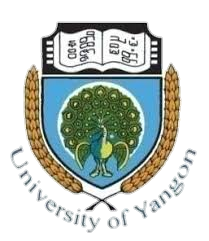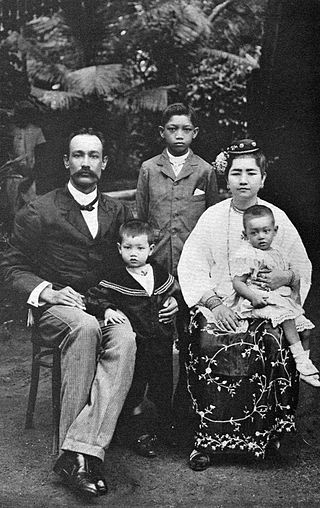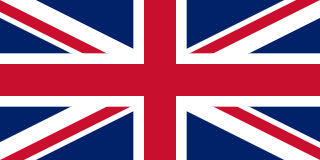
The Karen, also known as the Kayin, Kariang or Kawthoolese, are an ethnolinguistic group of Tibeto-Burman language-speaking people. The group as a whole is heterogeneous and disparate as many Karen ethnic groups do not associate or identify with each other culturally or linguistically. These Karen groups reside primarily in Kayin State, southern and southeastern Myanmar. The Karen account for around 6.69% of the Burmese population. Many Karen have migrated to Thailand, having settled mostly on the Myanmar–Thailand border. A few Karen have settled in the Andaman and Nicobar Islands, India, and other Southeast Asian and East Asian countries.
The culture of Myanmar (Burma) has been heavily influenced by Buddhism. Burmese culture has also been influenced by its neighbours.
Ba Maw was a Burmese lawyer and political leader, active during the interwar period and Second World War. He was the first Burma Premier (1937–1939) and head of State of Burma from 1942 to 1945.
Chinese Burmese, also Sino-Burmese or Tayoke, are Burmese citizens of Han Chinese ethnicity. They are a group of overseas Chinese born or raised in Myanmar (Burma). As of 2012, the Burmese Chinese population is estimated to be as high as 3 per cent of the country's population.

The University of Yangon, located in Kamayut, Yangon, is the oldest university in Myanmar's modern education system and the best known university in Myanmar. The university offers mainly undergraduate and postgraduate degrees programs in liberal arts, sciences and law. Full-time bachelor's degrees were not offered at the university's main campus after the student protests of 1996. The bachelor's degree was re-offered from 2014 on. Today degrees in Political Science are offered to undergraduate students, as well as postgraduate diplomas in areas such as social work and geology.

The Anglo-Burmese people, also known as the Anglo-Burmans, are a community of Eurasians of Burmese and European descent, who emerged as a distinct community through mixed relationships between the British and other Europeans and Burmese people from 1826 until 1948 when Myanmar gained its independence from the British Empire. Those who could not adjust to the new way of life after independence and the ushering in of military dictatorship are dispersed throughout the world. How many stayed in Myanmar is not accurately known.

The Armenian Church of Saint Gregory the Illuminator, referred to locally as the Armenian Church, is the oldest Christian church in Singapore, located at Hill Street in the Museum Planning Area, within the Central Area. The church was completed in 1835 and consecrated the next year. Originally a parish of the Armenian Apostolic Church, an Oriental Orthodox denomination, the last Armenian parish priest left in the late 1930s as Armenian population in Singapore dwindled. It was designated as a national monument in 1973. Armenian and Oriental Orthodox services are now regularly held at the church.

British colonial rule in Burma lasted from 1824 to 1948, from the successive three Anglo-Burmese wars through the creation of Burma as a province of British India to the establishment of an independently administered colony, and finally independence. The region under British control was known as British Burma, and officially known as Burma from 1886. Various portions of Burmese territories, including Arakan and Tenasserim, were annexed by the British after their victory in the First Anglo-Burmese War; Lower Burma was annexed in 1852 after the Second Anglo-Burmese War. The annexed territories were designated the minor province of British Burma in 1862.

Chinthe ; Shan: သၢင်ႇသီႈ ) is the Burmese word for 'lion'. The leograph of Chinthe is a highly stylized lion commonly depicted in Burmese iconography and architecture, especially as a pair of guardians flanking the entrances of Buddhist pagodas and kyaung.

The architecture of Penang reflects the 171 years of British presence on the island, coalescing with local, Chinese, Indian, Islamic and other elements to create a unique and distinctive brand of architecture. Along with Malacca, Penang is an architectural gem of Malaysia and Southeast Asia. Unlike Singapore, also a Straits Settlement, where many heritage buildings had to make way for modern skyscrapers and high-rise apartments due to rapid development and acute land scarcity, Penang's architectural heritage has enjoyed a better fate. Penang has one of the largest collections of pre-war buildings in Southeast Asia. This is for the most part due to the Rent Control Act which froze house rental prices for decades, making redevelopment unprofitable. With the repeal of this act in 2000 however, property prices skyrocketed and development has begun to encroach upon these buildings, many of which are in a regrettable state of disrepair. The government in recent years has allocated more funding to finance the restoration of a number of derelict heritage buildings, most notably Suffolk House, City Hall and historic buildings in the old commercial district.

The Sarkies Brothers, Martin (1852–1912), Tigran (1861–1912), Aviet (1862–1923), and Arshak (1868–1931), were a group of brothers of Armenian ethnicity best known for founding a chain of luxury hotels throughout Southeast Asia. The brothers were born in Isfahan, Iran.

Islam is a minority religion in Myanmar, practised by about 2.1% of the population, according to the 2014 Myanmar official statistics.

The Armenians in Singapore are a small community who had a significant presence in the early history of Singapore. They were among the earliest merchants to arrive in Singapore from the British Raj when it was established as a trading port by Sir Stamford Raffles in 1819. They numbered around 100 individuals at their peak in the early 1920s, but most have moved on to other countries or become absorbed into the wider Singapore community. Despite their small number, they had an impact in the commercial life of early Singapore and members of the community co-founded the newspaper The Straits Times and built the Raffles Hotel. The Armenian Apostolic Church of St Gregory the Illuminator on Armenian Street, the second church to be built in Singapore, is today the oldest surviving one.

The Strand is a Victorian-style hotel located in Yangon, Myanmar (Burma), built by Aviet and Tigran Sarkie, two of the Sarkies Brothers. The hotel, which opened in 1901, which faces the Yangon River to its south, is one of the most famous hotels in Yangon and Southeast Asia, and is managed by GCP Hospitality. The hotel is named after its address, at 92 Strand Road.

Christianity in Myanmar has a history dating to the early 18th century. According to the 2016 census, Christianity is the country's second largest religion, practiced by 6.3% of the population, primarily among the Kachin, Chin and Kayin, and Eurasians because of missionary work in their respective areas. In 2023, almost 8% of the population is Christian; about two-thirds of the country's Christians are Protestants, in particular Baptists of the Myanmar Baptist Convention. One in six Christians are Roman Catholics.

A kyaung is a monastery (vihara), comprising the domestic quarters and workplaces of Buddhist monks. Burmese kyaungs are sometimes also occupied by novice monks (samanera), lay attendants (kappiya), nuns (thilashin), and white-robed acolytes.

Dobama Asiayone, commonly known as the Thakhins, was a Burmese nationalist group formed around the 1930s and composed of young, disgruntled intellectuals. Drawing their name from the way in which the British were addressed during colonial times, the party was established by Ba Thaung in May 1930, bringing together traditionalist Buddhist nationalist elements and fresh political ideals. It was significant in stirring up political consciousness in Burma, and drew most of its support base from students.

The Karen conflict is an armed conflict in Kayin State, Myanmar. It is part of the wider internal conflict in Myanmar between the military government and various minority groups. Karen nationalists have been fighting for an independent state, known as Kawthoolei, since 1949. The Karen National Union (KNU) and its Karen National Liberation Army (KNLA) are the most prominent Karen rebel groups. Hundreds of thousands of civilians have been displaced by the conflict, many of whom fled to neighbouring Thailand and survive in refugee camps.

Arakan is the historical geographical name of Rakhine State, Myanmar. The region was called Arakan for centuries until the Burmese military junta changed its name in 1989. The people of the region were known as Arakanese.
Buddhism is a minor religion in Armenia, with a small but unknown number of adherents. The first direct contacts of Armenians with Buddhism occurred in the 13th century during the height of the Mongol Empire, culminating in the foundation of a Buddhist monastery in Armenia by the Buddhist emperor Hulegu Khan of the Ilkhanate after his conquest of Armenia when Buddhism was declared as an official religion. Contacts recurred elsewhere in subsequent centuries through Armenian merchants. In the 19th and early 20th centuries, Armenian intellectuals developed a strong interest in the religion.


















